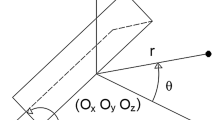We present theoretical approaches and a procedure for the FEM computation of parameters of nonlinear fracture mechanics in prismatic bodies with a crack. The efficiency of the proposed approaches and the veracity of the results obtained have been analyzed.















Similar content being viewed by others
References
V. A. Bazhenov, A. I. Gulyar, A. S. Sakharov, and A. G. Topor, Semi-Analytic Finite Element Method in Mechanics of Deformable Bodies [in Russian], NII SM, Kiev (1993).
V. A. Bazhenov, O. I. Gulyar, S. O. Pyskunov, and O. S. Sakharov, Semi-Analytic Finite Element Method for Problems of Fracture in Three-Dimensional Bodies [in Ukrainian], KNUBA, Kyiv (2005).
N. A. Grechukh, S. O. Pyskunov, and R. M. Ostapenko, “SIF calculations for three-dimensional bodies of revolution under thermal loading,” in: Strength of Materials and Theory of Construction [in Ukrainian], No. 80 (2006), pp. 38–53.
V. A. Bazhenov, A. I. Gulyar, S. O. Piskunov, and A. A. Shryl’, “Gas turbine blade service life assessment with account of fracture stage,” Strength Mater., 40, No. 5, 518–524 (2008).
G. P. Cherepanov, Brittle Fracture Mechanics [in Russian], Nauka, Moscow (1974).
J. Rice, “A path independent integral and the approximate analysis of strain concentrations by notches and cracks,” J. Appl. Mech., No. 4, 379–386 (1968).
V. A. Bazhenov, O. I. Gulyar, S. O. Pyskunov, et al., “Method of reactions for the J-integral calculations in three-dimensional nonlinear fracture mechanics problems,” in: Strength of Materials and Theory of Construction [in Ukrainian], No. 79 (2006), pp. 3–17.
E. M. Morozov and G. P. Nikishkov, Finite Element Method in Fracture Mechanics [in Russian], Nauka, Moscow (2007).
E. Giner, F. Fuenmayor, L. Baeza, and J. Tarancon, “Error estimation for the finite element evaluation of G I and G II in mixed-mode linear elastic fracture mechanics,” in: Finite Elements in Analysis and Design, Vol. 41 (2005), 41, pp. 1079–1104.
M. P. Savruk, Fracture Mechanics and Strength of Materials. Reference Book [in Russian], Vol. 2: Strength Intensity Factors in Cracked Bodies, Naukova Dumka, Kiev (1988).
Author information
Authors and Affiliations
Additional information
Translated from Problemy Prochnosti, No. 1, pp. 27 – 39, January – February, 2011.
Rights and permissions
About this article
Cite this article
Bazhenov, V.A., Gulyar, A.I., Piskunov, S.O. et al. Solving linear and nonlinear three-dimensional problems of fracture mechanics by a semi-analytic finite element method. Part 1. Theoretical background and a study of efficiency of fem procedure for solving three-dimensional problems of fracture mechanics. Strength Mater 43, 15–24 (2011). https://doi.org/10.1007/s11223-011-9263-3
Received:
Published:
Issue Date:
DOI: https://doi.org/10.1007/s11223-011-9263-3



